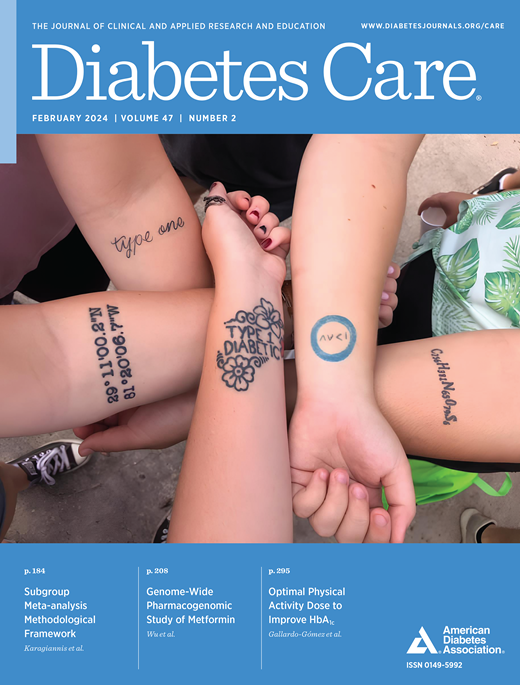包茎与SGLT2i和GLP-1RA相关的风险:一项丹麦队列研究
IF 16.6
1区 医学
Q1 ENDOCRINOLOGY & METABOLISM
引用次数: 0
摘要
目的钠-葡萄糖共转运蛋白2抑制剂(SGLT2i)可诱导高血糖,可能导致包皮微环境感染和炎症,从而增加包茎的风险。我们的目的是调查包茎在男性2型糖尿病患者中启动SGLT2i或胰高血糖素样肽-1受体激动剂(GLP-1RA)的风险。研究设计和方法在这项基于人群的主动比较新用户队列研究中,我们模拟了一项目标试验,纳入了2016年至2021年间丹麦所有开始使用SGLT2i或GLP-1RA的成年男性二甲双胍使用者。我们使用处理权重的逆概率来平衡潜在混杂因素的分布。我们估计了从基于人群的医学数据库中确定的包茎的加权意向治疗风险和风险比。在这项研究中,我们纳入了32486例SGLT2i启动者和14793例GLP-1RA启动者,中位随访时间为4年(最长8年)。SGLT2i使用者中包茎的风险升高。SGLT2i新使用者的1年包茎风险为0.9%,GLP-1RA新使用者的1年包茎风险为0.5%,对应的1年风险比为1.88 (95% CI, 1.43至2.47)。在8年的随访中,sgltti使用者包茎的风险累积高达4.8%,GLP-1RA使用者的风险累积高达3.6%,8年风险比为1.36 (95% CI, 1.14至1.61)。结论:与使用GLP-1RA相比,使用SGLT2i与2型糖尿病男性患者治疗1年后包茎风险增加近两倍相关。在8年的随访中,风险仍然升高,表明使用SGLT2i的风险持续升高。本文章由计算机程序翻译,如有差异,请以英文原文为准。
Risk of Phimosis Associated With SGLT2i Versus GLP-1RA: A Danish Cohort Study
OBJECTIVE Sodium-glucose cotransporter 2 inhibitors (SGLT2i) induce glucosuria, potentially leading to infection and inflammation in the preputial microenvironment, subsequently increasing the risk of phimosis. We aimed to investigate the risks of phimosis in males with type 2 diabetes initiating SGLT2i or glucagon-like peptide-1 receptor agonists (GLP-1RA). RESEARCH DESIGN AND METHODS In this population-based active-comparator new-user cohort study emulating a target trial, we included all adult male metformin users in Denmark initiating SGLT2i or GLP-1RA between 2016 and 2021. We used inverse probability of treatment weighting to balance the distribution of potential confounders. We estimated weighted intention-to-treat risk and risk ratios of phimosis identified from population-based medical databases. RESULTS In this study, we included 32,486 SGLT2i initiators and 14,793 GLP-1RA initiators with a median follow-up of 4 years (maximum 8 years). The risk of phimosis was elevated among SGLT2i users. The 1-year risk of phimosis was 0.9% among new SGLT2i users and 0.5% among new GLP-1RA users, corresponding to a 1-year risk ratio of 1.88 (95% CI, 1.43 to 2.47). During 8 years of follow-up, the risk of phimosis accumulated up to 4.8% in SGLT2i users and 3.6% in GLP-1RA users, with an 8-year risk ratio of 1.36 (95% CI, 1.14 to 1.61). CONCLUSIONS SGLT2i use was associated with a nearly twofold increased phimosis risk 1 year after treatment initiation in men with type 2 diabetes, compared with GLP-1RA use. Over 8 years of follow-up, the risk remained elevated, indicating a persistently higher risk associated with SGLT2i use.
求助全文
通过发布文献求助,成功后即可免费获取论文全文。
去求助
来源期刊

Diabetes Care
医学-内分泌学与代谢
CiteScore
27.80
自引率
4.90%
发文量
449
审稿时长
1 months
期刊介绍:
The journal's overarching mission can be captured by the simple word "Care," reflecting its commitment to enhancing patient well-being. Diabetes Care aims to support better patient care by addressing the comprehensive needs of healthcare professionals dedicated to managing diabetes.
Diabetes Care serves as a valuable resource for healthcare practitioners, aiming to advance knowledge, foster research, and improve diabetes management. The journal publishes original research across various categories, including Clinical Care, Education, Nutrition, Psychosocial Research, Epidemiology, Health Services Research, Emerging Treatments and Technologies, Pathophysiology, Complications, and Cardiovascular and Metabolic Risk. Additionally, Diabetes Care features ADA statements, consensus reports, review articles, letters to the editor, and health/medical news, appealing to a diverse audience of physicians, researchers, psychologists, educators, and other healthcare professionals.
 求助内容:
求助内容: 应助结果提醒方式:
应助结果提醒方式:


